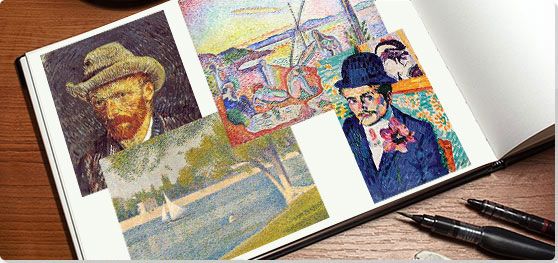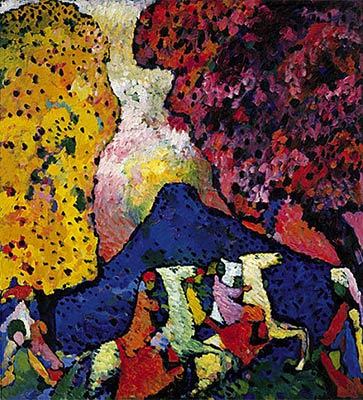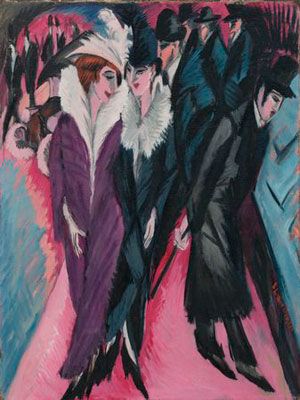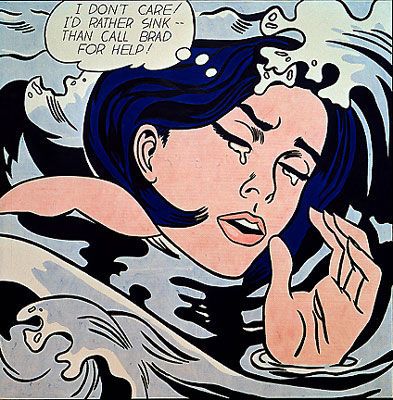Summary of Neo-Impressionism
In the latter part of the 19th century, Neo-Impressionism foregrounded the science of optics and color to forge a new and methodical technique of painting that eschewed the spontaneity and romanticism that many Impressionists celebrated. Relying on the viewer's capacity to optically blend the dots of color on the canvas, the Neo-Impressionists strove to create more luminous paintings that depicted modern life. With urban centers growing and technology advancing, the artists sought to capture people's changing relationship with the city and countryside. Many artists in the following years adopted the Neo-Impressionist technique of Pointillism, the application of tiny dots of pigment, which opened the door to further explorations of color and eventually abstract art.
Key Ideas & Accomplishments
- In order to more fully capture the luminosity seen in nature, the Neo-Impressionists turned to science in finding their painting technique of juxtaposing various colors and tones to create a shimmering, illuminated surface. By systematically placing contrasting colors, as well as black, white, and grey, next to each other on the canvas, the painters hoped to heighten the visual sensation of the image.
- Neo-Impressionists aimed to produce correspondences between emotional states and the forms, lines, and colors presented on the canvas that spoke to the modernity of urban life in the age of industrialization.
- Two terms closely associated with Neo-Impressionism - Divisionism and Pointillism - are practically interchangeable. Most broadly, Divisionism is a color theory that advocates placing small patches of pure pigment separately on the canvas in order that the viewer's eye will optically blend the colors. Divisionism became widely applied to any artist dividing or separating color while using small brushstrokes. Pointillism relied on the same theory of optical blending but specifically applied tiny separate "points," or dots, of pigment.
- Most of the Neo-Impressionists held anarchist beliefs. Their depictions of the working class and peasants called attention to the social struggles taking place as the rise of industrial capitalism gained speed, and their search for harmony in art paralleled their vision of a utopian society. The freedom they sought in scientific study furthered their abilities to overthrow bourgeois norms and conventions that hampered their individual autonomy.
Artworks and Artists of Neo-Impressionism
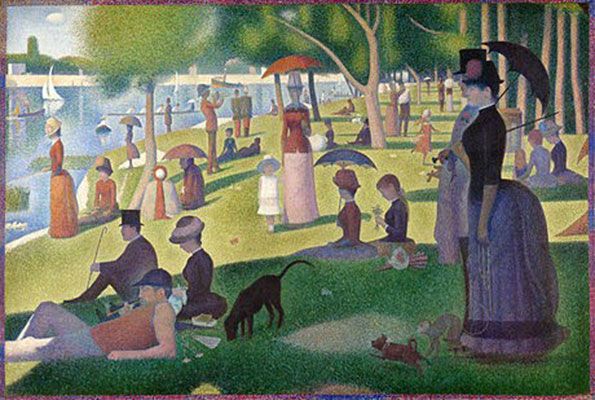
A Sunday Afternoon on La Grande Jatte
This most famous and influential Neo-Impressionist work depicts a cross section of Paris society enjoying a Sunday afternoon in the park on an island in the Seine River just at the gates of Paris. Sunday was the time that middle-class Parisians escaped the city to enjoy the outdoors. The people primarily gather in small groups of two or three or sit alone in proximity to others. It is the relationship between these people that creates a sense of modernity, with its distance and disconnection, and nervous tension that lends the work an air of mystery.
Using a grid system and applying small dots of paint, Seurat took two years to complete this large-scale painting. He went to the park often, observing and making over 60 preliminary studies, including 15 in oil. Invoking Greek classical art, Seurat explained, "The Panathenaeans of Phidias formed a procession. I want to make modern people, in their essential traits, move about as they do on those friezes, and place them on canvases organized by harmonies of color." Seurat hoped to capture the permanence, or essential forms, behind the fleeting moments. Everyone here is caught in a still pose, except for the child in the orange dress skipping off into the trees, the man on the far left playing a trombone, and the furious little dog at the lower right. However, it seems a stillness that might burst into movement at any moment, just as the upper half of the painting moves into sunlight and the boats in the distance cut across the river. While Seurat invoked classical and Egyptian figures, some have interpreted the overall static effect of the composition and the stiffness of the poses as a critique of the artificiality of modern society and the boredom of middle-class life.
Oil on canvas - The Art Institute of Chicago, Chicago IL
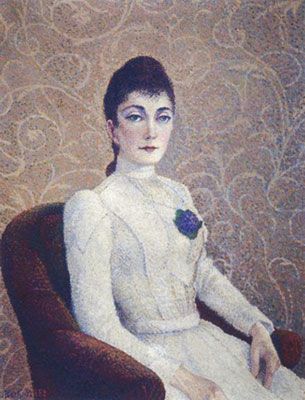
La Dame à la Robe Blanche (Woman in White)
This portrait of an unidentified woman was the first Neo-Impressionist portrait. As many of the group concentrated on depicting color in its greatest luminosity, their subject matter tended toward landscapes and cityscapes, but a few artists went beyond such subjects. The MAMC in Saint-Étienne, France has dubbed her "Madame P," but, at the time of the work's inception, Félix Fénéon called her Mademoiselle B. Seated in an upholstered chair, placed before a background wallpapered with floral arabesques, the woman dressed in white, a blue flower on her breast, looks with an indifferent gaze past the viewer.
Albert Dubois-Pillet was a career military officer and self-trained artist whose artistic endeavors were often discouraged by the military establishment. He met Signac and Seurat in 1884 and joined them in founding the Société des Artistes Indépendants. He began experimenting with Neo-Impressionism and by 1885 had adopted the Pointillist technique, becoming one of the first artists to do so. The shimmering effect of the subtle gold arabesques in the wall paper, the blue flower, and the touches of color in her white dress convey a sense of wealth and elegance, yet she seems static, as if her presence were meant to be the decorative element of the room.
Oil on canvas - Museum of Modern and Contemporary Art, Saint-Étienne, France
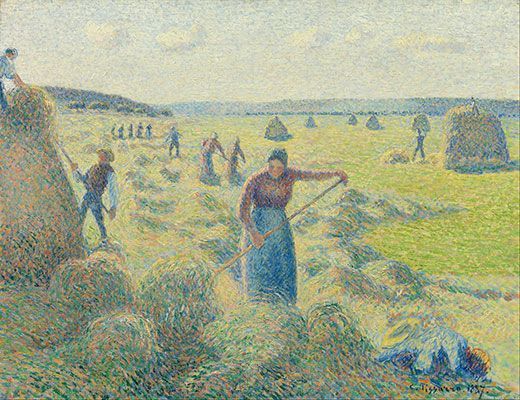
La Récolte des Foins, Éragny
This painting depicts a hay harvesting scene in the countryside near Éragny, where the artist lived with his family from 1884 until his death in 1903. In the center of the canvas, a woman uses a hayfork while behind her others do similar work in a brightly lit field punctuated by hay stacks.
Pissarro adopted the Pointillist technique in 1886, saying that "Neo-Impressionism was the next phase in the logical march of Impressionism." What set his work apart from the other Neo-Impressionists was his emphasis upon rural life and labor. Pissarro's depiction of peasant life along with his own scientific explorations of color speak to the anarchist theories he adopted in the latter half of the 1870s.
Pissarro felt that his scientific studies freed him from the Academy's strictures of how to see and depict reality. He also evoked the utopian visions of peasant societies he read about in the writings of anarchists Pierre-Joseph Proudhon and Peter Kropotkin. Pissarro wanted "to educate the public," by portraying the common man, but he also wanted to avoid idealizing and sentimentalizing his subjects. In this work, he depicts the effort of hay harvesting, both in the man at the left arching his back to toss the hay up, and in the woman at the center, the strength palpable in her back and shoulders.
Oil on canvas - The Van Gogh Museum, Amsterdam
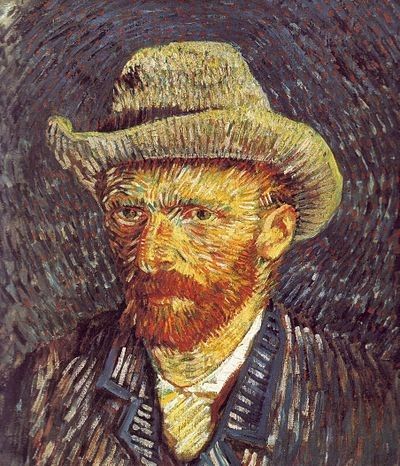
Self-Portrait with Felt Hat
While more famously known for his profound influence on the future Expressionist movement, Vincent van Gogh was greatly influenced by the Neo-Impressionist works he encountered in Paris in 1886. In the same year he painted this work and just before leaving for Arles, he was encouraged in his own explorations of color by a last minute visit to Seurat's studio, which he called a "fresh revelation of color."
In early 1887 van Gogh moved to Asnières, a Paris suburb, and met Signac, and he adopted the Divisionist style. Using short strokes of green and red in the methodical manner of Signac and Seurat, his Self-Portrait of 1888 is one of his first Neo-Impressionist works. He uses complementary colors - orange and blue for the background, green and red in his eyes and beard - to intensify one another.
Van Gogh varied the Neo-Impressionist technique in a highly individualized manner. His short brushstrokes are slightly longer and move in varying directions, creating a rhythmic swirl of paint across the canvas. Rather than a mosaic-like effect, the brushstrokes create an emotional intensity and scathingly honest self-observation that presages Expressionism.
Oil on canvas - The Van Gogh Museum, Amsterdam
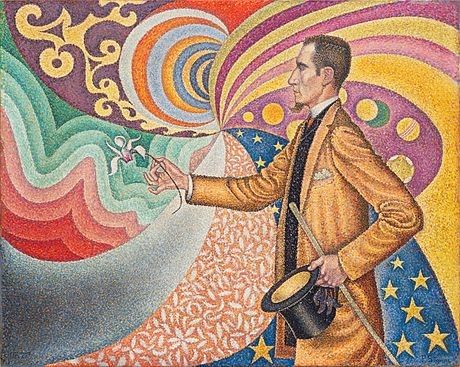
Against the Enamel of a Background Rhythmic with Beats and Angles, Tones, and Tints, Portrait of Félix Fénéon
Signac depicts the art critic Félix Fénéon in profile in front of a swirling, mesmerizing backdrop. With his distinctive goatee, top hat, and cane, and holding a flower in one hand, Fénéon is the very image of a flâneur, an erudite wanderer of city streets who both observed and critically participated in urban life. The background is remarkably innovative with its abstract swirls of complementary colors that resemble a color wheel, and its stars and planet-like circles suggest a kind of rainbow view of the cosmos, arranged harmoniously around its central human figure. Signac depicts the critic as a kind of trail blazer initiating a new world of art.
Signac's use of the word "enamel" in the title suggests the influence of decorative arts and of Cloisonnism, a style used by the artists Paul Gauguin, Louis Arquetin, and Emile Bernard, among others, based upon stained glass and medieval cloisonné work that used intense color planes with defined outlines. Signac did a number of preparatory studies for the background to come up with the right pattern, which was finally based upon the material of a kimono in a Japanese Ukiyo-e print that he owned.
Oil on canvas - The Museum of Modern Art, New York
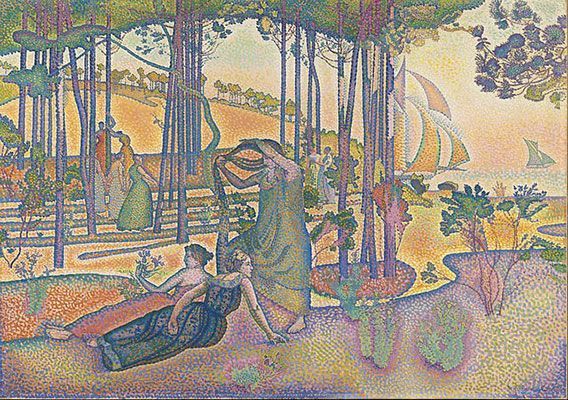
The Evening Air
Living in the South of France in 1893, Henri-Edmond Cross painted this work in response to a friendly challenge from Signac: "Since we both know and love this sunny land, why don't we both raise a decorative monument to it?" Signac painted In a Time of Harmony, and Cross created this painting, depicting a number of women in a wooded area along the seashore where several sailboats glide past. The setting sun bathes the Arcadian landscape of southern France in soft but vibrant colors and the women in classical attire seem timeless.
Cross, like Seurat and other colleagues, was influenced by the classical composition and ideal landscapes of Puvis de Chavannes. Here Cross looks specifically to Sweet Land (1882) for his composition. Cross adapted the Pointillist technique to the large scale of his canvas. Rather than tiny dots, he used larger rectangular brushstrokes to create a mosaic-like effect. In its decorative and monumental intent, the work was a new direction for him. In 1894 after exhibiting it at the Salon des Indépendants, he gave the work to Signac who displayed it in his dining room. There, the artist Henri Matisse first encountered the painting, which inspired his Luxe, Calme et Volupté (1904).
Oil on canvas - Musée d'Orsay, Paris
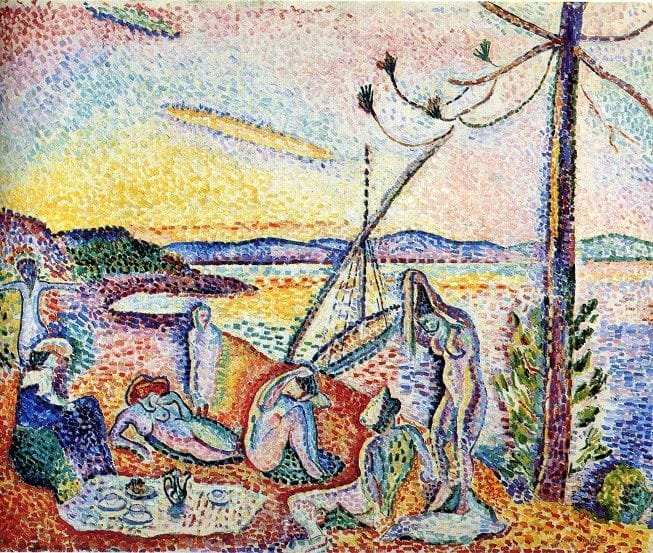
Luxe, Calme et Volupté (Luxury, Calm and Pleasure)
This painting depicts a sunny shore on the French Rivera, where six nude women in classical poses gather around a picnic blanket before which a clothed and bearded older man is sitting. The sea reaches to the horizon, its expanse broken by the diagonals of a thin yellow cloud and the folded sail of a boat.
The title of the work is taken from Charles Baudelaire's poem "L'invitation au voyage," "There, all is order and beauty, / Luxury, peace, and pleasure." Matisse depicts his interpretation of this idyllic landscape of aesthetic pleasures.
While spending the summer in St. Tropez in 1904, Matisse worked closely with Signac and Cross, depicting the view of the shore from Signac's house. The classical forms and the short brushstrokes signal Matisse's interest in the subjects and techniques of Neo-Impressionism, yet Matisse seems less interested here in the optical mixing of the colors that was so important to the movement. Instead, the strokes, a little too far apart, signal the flatness of the picture plane. Its dynamic and brightly clashing color palette and its almost cut-out figures made it the first work of the new Fauvist movement.
Oil on canvas - Musée d'Orsay, Paris
Coucher de soleil no. 1
Metzinger presents a lush Mediterranean landscape with trees, a body of water in the background, and bright vegetation, all lit by the radiance of the setting sun. It is only on close inspection that the viewer notices two small, nude female figures who practically meld with the landscape.
Active in the Neo-Impressionist revival, Metzinger began to move away from naturalism in the early 1900s by incorporating Cross's brushstrokes that created a mosaic effect and Seurat's geometry. The landscape is very much a paradise, and the nudity of the two women, by not being featured prominently, is just an aspect of a freer and more natural state of being.
The sun here is a solar disk, as the art historian Robert Herbert wrote, paying "homage to the decomposition of spectral light that lay at the heart of Neo-Impressionist color theory..." An image of the sun vibrating in concentric circles was also used in Robert Delaunay's Paysage au Disque (1906-1907), who adopted the image as a personal symbol. Close friends and colleagues at the time, the two artists painted portraits of each other that used small blocks of contrasting pigments, which were called "cubes," and developed into a proto-Cubist style.
Oil on canvas - Kröller-Müller Museum, Otterlo
Beginnings of Neo-Impressionism
Georges Seurat and Chromoluminarism
By the mid-1880s, feeling that Impressionism's emphasis on the play of light was too narrow, a new generation of artists, including Georges Seurat, Paul Gauguin, Henri Toulouse-Lautrec, and Vincent van Gogh, who would later be referred to more generally as Post-Impressionists, began developing new approaches to line, color, and form. In 1879 after leaving the École des Beaux-Arts where he'd studied for a year, Seurat said he wanted "to find something new, my own way of painting." He particularly valued color intensity in painting, and took extensive notes on the use of color by the painter Eugène Delacroix. He began studying color theory and the science of optics and embarked on a path that would lead him to develop a new style he called Chromoluminarism.
The Theory of Neo-Impressionism
The discoveries of "optical blending" and "simultaneous contrast" that Seurat read about became the theoretical foundation of Chromoluminarism, which came to be known as Neo-Impressionism. While working at Gobelins dye factory in Paris, Michel-Eugène Chevreul had to answer customer complaints about the quality of the yarn's color. While trying to address the problem, he discovered the principle of "simultaneous contrast," or the effect of the color of an adjacent yarn on the perception of another yarn's color. Subsequently Chevreul wrote The Principles of Harmony and Contrast of Colors in 1839. Ogden Rood's Modern Chromatics discussed how the viewer's eye "blends" or "mixes" adjacent colors, and David Sutter's Phenomena of Vision (1880) established rules for the relationship between painting and science. To achieve the most brilliant colors and a shimmering effect, Neo-Impressionism relied upon applying dots or brushstrokes of complementary colors to the canvas. Rather than mixing pigments on a palette, Neo-Impressionist painters relied on the viewer's eye to "blend" the colors that appeared on the canvas.
Though some of these theories are now considered only quasi-scientific, at the time they seemed cutting edge. Seurat felt he had discovered the science of painting, one that required discipline and precise application and that could achieve an intensity of color. He applied his color theory and a new technique that he called balayé, criss-crossing strokes to apply matte colors, in his 1884 Bathers at Asnières, a monumental work that depicts a number of workmen bathing in the river on a hot summer day.
Subsequently Seurat began work on A Sunday Afternoon on the Island of La Grande Jatte (1884) by undertaking extensive preliminary studies and sketches. Depicting the bourgeoisie in the park along the river, the work used the Pointillist style Seurat developed - tiny dots of complementary colors placed next to each other.
In 1890 Seurat published Esthetique, his foundational work on Neo-Impressionism's scientific color theory. Other Neo-Impressionists were to continue exploring this scientific basis; for instance, around 1887 Albert Dubois-Pillet developed the idea of passage, where the separate pigment of each of the primary light colors created a passage between different hues.
The First Circle of Neo-Impressionists
In 1884 the artist Paul Signac met Seurat and became an ardent advocate of both his color theory and his systematic working method. Though Seurat was the rigorous and reserved theoretician of the movement, Signac was its extroverted leader and advocate. The two men had a close working association, and it was Signac who came up with the name "Pointillism."
In 1885, Seurat submitted Bathers at Asnières to the Salon, the official exhibition of the Academy of Beaux-Arts, but the committee rejected it. Not only were they perplexed by the painting's formal composition, monumental scale, and experimental technique, but Seurat's depiction of lower class workman during relaxation rankled the staid bourgeoisie and academicians. Subsequently, Seurat and Signac, along with Albert Dubois-Pillet and Odilon Redon, co-founded the Salon des Indépendants in response to the rejection. As a result, Camille Pissarro met Seurat and Signac in 1885 and both he and his son, the artist Lucien Pissarro, along with Henri-Edmond Cross, and Charles Angrand, became the first group of Neo-Impressionists.
The Debut of Neo-Impressionism
1886 was a turning point in the art world, as the eighth and final Impressionist exhibit also marked the advent of Neo-Impressionism with the showing of Seurat's newly completed painting, A Sunday Afternoon on La Grande Jatte. The only artist to have participated in all eight Impressionist exhibits, Pissarro invited Seurat to show in the exhibition.
A Sunday Afternoon on La Grande Jatte was also shown at the Salon of the Société des Artistes Indépendants where it drew even more attention, including that of the art critic, Félix Fénéon, who coined the term "Neo-Impressionism," and became an ardent advocate for the movement in the years that followed. Other French artists, such as Maximilien Luce, Leo Gausson, and Louis Hayet, also joined the movement.
Neo-Impressionism, Anarchism and Arcadia
While Seurat's particular politics are not entirely clear, from the beginning Neo-Impressionism was strongly connected to the anarchist movement, which had a strong foothold in France and in the artistic community. Before becoming an art critic for La Revue Blanche, Félix Fénéon was already famous for his anarchist sympathies. Arrested along with twenty-nine others, solely for their anarchist views, and charged with conspiracy in the assassination of Sadi Carnot, the French President, all thirty were found not guilty. As a result of the trial, Fénéon had a formidable reputation for independent thinking and defiance of social convention, and, as a critic, linked Neo-Impressionism with advocacy for anarchism.
In the 1880s Signac became a committed anarchist, financially supporting the movement, and, along with Henri-Edmond Cross, Maximilien Luce, and Camille Pissarro, writing for the anarchist newspaper, Les Temps Nouveaux (The New Times.) He read Élisée Reclus and Peter Kropotkin, both radical geographers, along with Pierre-Joseph Proudhon, all of whom argued for a utopian society based on small groups and free association. These anarchists gave further impetus to Signac's view that Neo-Impressionist work was connected to a harmony derived from human freedom in a natural environment, which informed much of their subject matter. Furthermore, the artists' pursuit of scientific inquiry complemented their anarchist views in freeing them from the impositions of imposed tastes of the bourgeoisie.
The Revival of Neo-Impressionism: Stylistic Changes
Seurat died at a young age in 1891, and Signac became the putative leader of the group. The publication of Signac's manifesto From Eugene Delacroix to Neo-Impressionism, led to a revival of the movement in 1898, making it an international movement, yet again allied with anarchist sympathies. The manifesto, along with his works like the 1895 Saint-Tropez, l'orage (Saint-Tropez, the storm) drew a new generation of artists, including Henri Matisse. Signac became president of the Société des Artistes Indépendents in 1908 and held the position, advocating for Neo-Impressionism, until 1934, the year before his death.
Signac and Cross also created stylistic changes in Neo-Impressionism that had a great impact on other artists. Signac began using luxuriant color, as can be seen in his 1898 Capo di Noli with its pink mountains, and, rather than painting in dots, used small brushstrokes that allowed for dynamic flexibility. In his landscape, The Golden Isles, completed between 1891-1892, Cross used round brushstrokes in varying sizes to create a sense of perspective as the tiniest dots approached the horizon. Also showing the influence of Japanese Ukiyo-e prints in its high horizon, the work is notable for its near abstract quality. But it was the mosaic-effect of his works like his 1896 La Plage de Saint-Clair that most influenced his contemporaries. To create this effect, Cross used short, wide brushstrokes that resembled small blocks and left small areas of the canvas unpainted. The emphasis was on keeping contrasting colors separate rather than having them blend. Cross felt, as he said, "far more interested in creating harmonies of pure color, than in harmonizing the colors of a particular landscape or natural scene."
Neo-Impressionism: Concepts, Styles, and Trends
By the 1890s Neo-Impressionism had become an international movement, adopted by many European artists. The movement remained remarkably consistent in its reliance on color theory and its use of small dots or small brushstrokes. As a result, its development is best organized by regional interpretations.
French Neo-Impressionism
In France, Neo-Impressionism attracted a great many artists of successive generations, though each of them adapted the style to his individual preoccupations. A few Impressionists, including Camille Pissarro and Charles Angrand, took up the movement. Pissarro, using the Pointillist technique, retained his work's focus on rural life and peasant labor. Angrand used a more muted palette to depict shadow and tone, as shown in his 1887 Couple in the Street. Maximilien Luce depicted more contemporary scenes, often passionately portrayed with intense contrasts of light.
In the 1890s with the revival of the movement, a new generation of artists was influenced by Neo-Impressionism. Cross's mosaic-like work influenced Signac, as well as younger artists like Henri Matisse, Henri Manguin, Jean Metzinger, Robert Delaunay, and André Derain. These artists also individually adapted the style, as can be seen in Metzinger and Delaunay's use of small brushstrokes to resemble small cubes of color, and in Matisse's evolution toward an ever more intense color palette.
Belgian Neo-Impressionism
The Belgian Impressionist Théo Van Rysselberghe was stunned by Seurat's A Sunday Afternoon on La Grande Jatte when he saw it in Paris in 1886. Along with a group of other artists, including Georges Lemmen, Xavier Mellery, Willy Schloback, Henry Clemens van de Velde, Alfred William Finch, and Anna Boch, he introduced the style to the Belgian art world where it had a significant influence. From his travels to Morocco, he created a number of pointillist landscapes, but it was his 1888 Portrait of Alice Sethe that became his signature work. Due to his influence portraiture became a significant aspect of Belgian Neo-Impressionism.
Alfred William Finch, a founding member of the Les Vingt, a Brussels group which tried to free Belgian art from narrow nationalistic traditions by focusing on French contemporary models, saw the work of Seurat and Signac at Les Vingt show in 1886, and also became a leading proponent. Depicting an empty sky above a surging sea, his Breaking Waves at Heyst (1891) has a strong emphasis on pattern and design, which has a flattening and decorative effect. The emphasis on pattern of colors is also apparent in the work of Henry Clemens van de Velde.
Dutch Neo-Impressionism
From 1882-1890, the artist Jan Toorop studied in Brussels where he encountered the work of Seurat and Signac. He developed an individualized style that synthesized Divisionism with other artistic influences that he had encountered, and was recognized as an important innovator in Holland. His 1889 Neo-Impressionist painting, Broek in Waterland, depicting a couple in a boat along a canal at sunset, has a strong element of design and pattern. He joined the Hague Art Circle, and helped organize an exhibition, that presented the works of Seurat, Signac, Pissarro, Rysselberghe, Van de Velde, and others. The exhibition received a great deal of favorable attention and was visited by Van de Velde who created a number of significant relationships with Dutch artists. As a result, the young artists Johan Joseph Aarts, Petrus Bremmer, and Jan Vijibrief became Neo-Impressionists. Bremmer was to have a significant influence as a teacher and a writer, urging the use of a bright clear palette.
However, the most important innovative Dutch artists to take up Pointillism early in their careers were Vincent van Gogh and Piet Mondrian. Van Gogh met Signac in 1887 in Paris and adopted elements of the style into his highly individualized expression. Of a later generation of artists, Mondrian adopted the style, and wrote in 1909, "I believe that in our period it is definitely necessary that, as far as possible, the paint is applied in pure colors set next to each other in a pointillist or diffuse manner. This is stated strongly, and yet it relates to the idea which is the basis of meaningful expression in form." Both artists moved beyond Divisionism to explore and develop other artistic means.
Italian Neo-Impressionism
The artist and art critic Vittore Grubicy de Dragon introduced Divisionism to Italian artists in the late 1880s. He spent 1882-1885 in the Netherlands, where he met and was influenced by the artist Anton Mauve, a cousin-in-law of Vincent van Gogh and an advocate for the movement. At the First Triennale in Milan in 1891, two Divisionist works received the most attention. Giovanni Segantini, who had an international reputation, exhibited The Two Mothers (1889) to great acclaim, while Gaetano Previati's Motherhood (1890-1891) was violently attacked. Previati had intensely studied Divisionism and had written the only scholarly work on the technique at the time. While having an advanced knowledge of the perception of color, he also felt that by using intense color to vividly engage the eye an emotional and spiritual resonance would be felt. Motherhood is now viewed as the debut work of Italian Neo-Impressionism, and a turning point for Italian modern art with its engagement with Symbolism and its influence on Italian Art Nouveau and Expressionism.
Divisionism was to be centered primarily in Northern Italy, and while the work often focused on landscape, it reflected Segantini's statement that art has "nothing to do with the imitation of the real, because creation is possible only through the drive of the spirit and the human soul." Giuseppe Pelizza da Volpedo's The Mirror of Life (1895-1898), depicting a flock of sheep in a landscape, was described by the artist Cesare Viazzi as conveying "the living sense of perfect calms ought in the gentle abandonment of Nature's predestined events." Many of the works were Symbolist, or at least allegorical, and there was also an intent to often reply to social conditions. Pelizza's most famous work was his 1901 Il Quarto Stato (The Fourth Estate). Originally titled The Path of Workers and depicting a strike, the work became a rallying symbol for the Italian socialist movement.
Germany and Austrian Neo-Impressionism
The 1890s in Germany and Austria marked an era of Secessions, art movements that broke away from the conservatism of official academies and emphasized modern art. The Munich Secession of 1892, the 1897 Vienna Secession, and the 1898 Berlin Secession had no manifesto and exhibited the work of all the contemporary movements, and Neo-Impressionism was featured prominently. Artists like Berlin's Curt Hermann adopted the style, though combining it with the naturalism of en plein air painting.
However, the style had the greatest influence on a younger generation of artists. Following the translation of Signac's From Delacroix to Neo-Impressionism into German in 1903 and the Neo-Impressionist show of 1904, the Expressionist Ernst Ludwig Kirchner painted Divisionist works like Park Lake in Dresden (1906). Other young artists adopted the style, as seen in Karl Schmidt-Rottluf's Country Road in Springtime (1905) and Erick Heckel's The Elbe at Dresden (1905), and inched it toward Expressionism as seen in Heckel's furious brush strokes to depict the churning water. For these artists, Neo-Impressionism was an international style that broke the dominance of Impressionist art, allowing the artists to focus on the properties and potential effects of color alone.
Later Developments - After Neo-Impressionism
Even after Seurat’s death in 1891, Neo-Impressionism had a wide influence, both upon individual artists and the development of art movements including Art Nouveau, Fauvism, Cubism, Die Brücke, Orphism, Italian Futurism, and the movement toward abstraction. As art historian Claire Maignon wrote, "Neo-Impressionism showed a capacity for abstraction - in the sense of 'to subtract from' - that was a constituent element of its modernity. From the world it extracted formal qualities, universal archetypes, color sensations and lines that would be the departure points for many modernist experiments." While many artists took up the technique and then moved on to other styles, Signac, one of the original Neo-Impressionists, continued to paint in the style until his death in 1935.
The movement's emphasis on color and the sensations it evoked in the viewer encouraged a breaking away from naturalistic depictions of color. Fauvism made its debut in Matisse's Luxury, Calm and Pleasure of 1904. Other leaders of Fauvism, like Andre Derain and Maurice de Vlaminck painted Divisionist landscapes, like Derain's Houses of Parliament in 1906.
Delaunay and Metzinger, among others, developed the small brush strokes of later Neo-Impressionism into small cube-like shapes. These small "cubes" and Seurat's emphasis on geometry in painting influenced Metzinger as he moved toward Cubism. Georges Braque's Cubism was also influenced by Seurat's geometry. Delaunay's interest in pure color led to the development of Orphism, as can be seen in his Paysage au disque (1906-1907) with its radiant sun with concentric rings, an image that became his artistic emblem.
The Belgian Neo-Impressionist Finch later became a ceramicist, working in Finland where he helped develop the Art Nouveau style of the region. Neo-Impressionist patterns of color also influenced Henry Clemens van de Velde, who later became one of the founders of Belgian Art Nouveau. The decorative effect and arabesque pattern of Signac's later work became a central influence upon the development of Art Nouveau among the artists of the Vienna, Munich, and Berlin Secessions.
In Germany, Ernst Ludwig Kirchner, along with Karl Schmidt-Rottluf and Erick Heckel, began as Neo-Impressionists. The three artists, along with others, went on to found the art movement, Die Brücke. Wassily Kandinsky admired the color theory and the movement, describing it as the desire "to represent the whole of nature in all its glory and splendor," and adopted the style in his early work. Piet Mondrian and Kazimir Malevich also worked in the Divisionist style early in their careers, and it influenced their later work's departure from figuration.
In 1901, the Italian artists Gino Severini and Umberto Boccioni were introduced by Giacomo Balla to what he called painting in "divided" light and began painting in the Divisionist style. The emphasis upon the breaking down of light influenced the three artists' development of Italian Futurism in its breaking down of movement. Balla's Street Lamp of 1909 is both a dynamic Futurist work and an application of Divisionist technique.
Paul Klee adopted Pointillism and in his Bauhaus teaching in the 1920s continued to develop color theory. Both the technique and his color theory can be seen in the bright but contrasting color and small cubes of a number of his works, including his 1932 painting, Ad Paranassum.
Neo-Impressionist techniques and theories have had a continuing influence on more contemporary artists. American Pop artist Roy Lichtenstein created works like Drowning Girl (1963) by using stencil dot patterns that not only recall the printing process of newspapers and magazine but also the dots of color in Neo-Impressionist paintings. The American artists and close friends, Chuck Close and John Roy both incorporated Pointillism with photorealism. Using a grid pattern, Close used a variety of 'points,' from pixels to cells, in creating his work. The Dutch artist, Ger van Elk, has created a number of what he calls flatscreens, moving images based on the paintings of the works of Seurat, Signac and Cross, Snow over Seurat and Seurat's La Grève de Bas-Butin à Honfleur, both shown simultaneously in 2004 in Amsterdam.
And finally, Seurat's Sunday Afternoon on La Grande Jatte can be found often in popular culture. Steven Sondheim's 1984 Broadway musical, Sunday Afternoon in the Park with George, which won the Pulitzer Prize and two Tony awards, is based on the painting. The work has shown up in movies, like Barbarella (1968) and, significantly, in Ferris Bueller's Day Off in 1986. Cartoons like Looney Tunes, Sponge Bob, and The Simpsons have all parodied it, as have children's books and shows like Babar the Elephant and Sesame Street. Countless magazine covers have recreated the image.
Useful Resources on Neo-Impressionism
- Georges Seurat: The Art of VisionBy Michelle Foa
- The Neo-Impressionist Portrait, 1886-1904By Jane Block and Ellen Wardwell Lee
- Neo-Impressionism and the Dream of Realities: Painting, Poetry, MusicOur PickBy Cornelia Homburg
- Neo-Impressionism and the Search for Solid Ground: Art, Science, and Anarchism in Fin-de-Siecle FranceBy John C. Hutton
- Maximilien Luce: Neo-Impressionist: RetrospectiveBy Vanessa Lecomte, Aline Dardel, Marina Bocquillon, et al.
- Pissarro, Neo-Impressionism, and the Spaces of the Avant-GardeBy Martha Ward and Camille Pissarro
- Divisionism/Neo-Impressionism: Arcadia & AnarchyBy Vivien Green, Giovanna Ginex, Dominique Lobstein, et al.
- Neo-Impressionism and Anarchism in Fin-de-Siècle France: Painting, Politics and LandscapeBy Robyn Roslak
